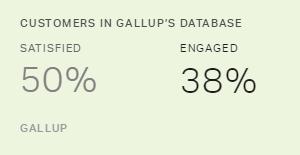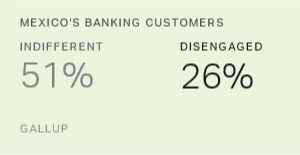Story Highlights
- Customer engagement doesn't automatically follow satisfaction, or vice versa
- Engaging or satisfying customers -- or doing both -- is a strategic choice
- Success flows from the organizational norms senior leaders create
Customer engagement and customer satisfaction are distinctly different metrics.
In fact, engagement is a much higher bar to reach than satisfaction. According to Gallup's customer database, half of all customers (50%) say they are satisfied with a given brand, but only 38% of customers say they are engaged with one. That's because it takes a lot more to engage a customer than to satisfy one.
| Satisfaction Attribute Example | Engagement Attribute Example | ||||||||||||||||||||||||||||||||||||||||||||||||||||||||||||||||||||||||||||||||||||||||||||||||||
|---|---|---|---|---|---|---|---|---|---|---|---|---|---|---|---|---|---|---|---|---|---|---|---|---|---|---|---|---|---|---|---|---|---|---|---|---|---|---|---|---|---|---|---|---|---|---|---|---|---|---|---|---|---|---|---|---|---|---|---|---|---|---|---|---|---|---|---|---|---|---|---|---|---|---|---|---|---|---|---|---|---|---|---|---|---|---|---|---|---|---|---|---|---|---|---|---|---|---|---|
| Hospitality | Wide array of in-room amenities | Lobby was active and energetic | |||||||||||||||||||||||||||||||||||||||||||||||||||||||||||||||||||||||||||||||||||||||||||||||||
| Retail | Has great sales, discounts and deals | Went out of their way to be helpful | |||||||||||||||||||||||||||||||||||||||||||||||||||||||||||||||||||||||||||||||||||||||||||||||||
| Banking | Courtesy of the bank representative | Was interested in improving financial health | |||||||||||||||||||||||||||||||||||||||||||||||||||||||||||||||||||||||||||||||||||||||||||||||||
| Fast Food | Speed of food preparation | Warmth of the welcome greeting | |||||||||||||||||||||||||||||||||||||||||||||||||||||||||||||||||||||||||||||||||||||||||||||||||
| Airlines | Wait time to retrieve bag | Takes care of its loyal customers | |||||||||||||||||||||||||||||||||||||||||||||||||||||||||||||||||||||||||||||||||||||||||||||||||
| Gallup | |||||||||||||||||||||||||||||||||||||||||||||||||||||||||||||||||||||||||||||||||||||||||||||||||||
But the common misperception is that one follows the other -- that higher satisfaction will lead to higher engagement, or vice versa. This is untrue, and various combinations of the two exist.
Companies' relationships with customers fall into four quadrants: low satisfaction/low engagement; high satisfaction/low engagement; low satisfaction/high engagement; and high satisfaction/high engagement.
Obviously, no company wants to fall into the first quadrant, and the fourth quadrant is ideal. But many highly successful organizations fall into the middle two quadrants, and there's nothing wrong with that -- as long as the company's leadership and strategy aim to be there.

- Quadrant I: Low Satisfaction/Low Engagement -- Doomed Relationship: In this quadrant, aspects of a company's customer experience -- such as product features, price, convenience or speed -- tend to be far worse than for many of its competitors. Moreover, there is no emotional insulation in the experience to convince customers to put up with it. No company should be here.
- Quadrant II: High Satisfaction/Low Engagement -- Relationship of Convenience: In this quadrant, the rational aspects of the customer experience -- usually either price or product features -- are quite appealing, but there isn't a strong emotional connection. It is not the company that customers want; it's what the company offers. When the offer amounts to less than the competition's offer, the relationship is in jeopardy. Market-share leaders who have scale, pricing power and innovative models of delivery -- such as big-box retailers or fast-food chains -- usually fall into this category.
- Quadrant III: Low Satisfaction/High Engagement -- Insulated Relationship: Companies in this quadrant are known for their emotional connections with customers -- yet they are barely acceptable on the fundamentals. The high engagement of their customers creates loyalty through emotion despite the lagging rational aspects of the experience. For these companies, engagement provides insulation, and the rational factors become largely secondary. Highly successful, upscale hotel chains and theme parks can fall into this quadrant.
- Quadrant IV: High Satisfaction/High Engagement -- Dual-Path Relationship: Companies in this quadrant understand that a competitive rational experience is not enough to attain a market edge. Businesses must also make memorable and meaningful emotional connections, typically through human channels such as great service. Nordstrom and Southwest Airlines are great companies that fall into this quadrant.
Clearly, customers with low satisfaction and low engagement (Quadrant I) aren't going to stay customers for long. But that doesn't mean Quadrant IV -- high satisfaction and high engagement -- is the only option. With the exception of Quadrant I, each quadrant has strategic merit. The best quadrant for a given organization depends on what the organization's senior leaders believe they can credibly win in the marketplace. The key is to understand that it's a strategic choice.
Senior Management Creates Organizational Norms
Realizing success is ultimately a function of organizational behaviors (or norms), no matter the strategic choice. How employees get work done bridges the gap between strategy and execution.
But let's set the record straight. Organizational norms are not created by employees or even catch-all leadership; they're created by senior leadership. Culture and, thereby, performance are reflections of senior leadership behavior. Leadership culture influences company culture.
The best senior leaders are intentional -- their decisions, actions and reactions do nothing but advance the fundamentals in their given quadrant. Here are their key strategies:
- Clarify the purpose and mission. How well senior leaders define the company's purpose and mission is vital. If an organization's purpose is "why it exists," then its mission is "how it brings that purpose to life" -- its business plan. For example, Southwest Airlines' purpose is to "connect people to what's important in their lives." This purpose is operationalized through its mission: "friendly, reliable and low-cost air travel." The mission must be crystal clear or the purpose is lost.
- Reverse-engineer the culture. Great organizations obsess over their purpose and mission. Organizational norms must be reverse-engineered to serve the mission, even if that means reshaping the operational or corporate structure.
- Invest in what matters. Companies are what they invest in. The best organizations invest time, energy and money into the advancement of their mission. Financial institutions are typically a terrible example of this. In an industry in which employees provide the biggest opportunity for competitive differentiation, financial institutions spend a disproportionate amount of time, energy and money on everything but their workforce.
- Measure the right things. This seems fairly straightforward, but many companies measure their success in sales, time and satisfaction based on averages, or they measure the entirely wrong things. First, customers don't experience "averages"; they experience their moment, and the best companies take that moment seriously. They want data as local as it gets -- division, location, employee. On the other end, many organizations spend a lot of time improving metrics that don't match their mission or quadrant. For example, many organizations talk about engagement but measure only satisfaction.
A company's value proposition to the marketplace (whether it be satisfaction, engagement or both) depends on consistency and persistence in these four areas. Many senior leaders talk about their strategy while doing a bunch of things that distract from the mission needed to deliver it. This mismatch between word and deed can create a lot of waste and lackluster performance. Senior leaders who are intentional in connecting mission and strategy can turn mission-critical organizational norms into organizational strengths.


